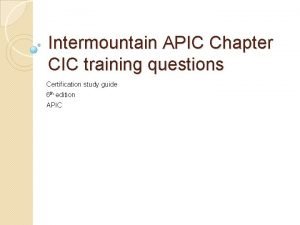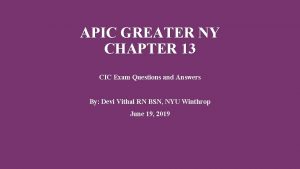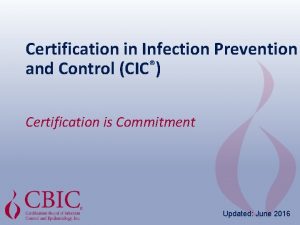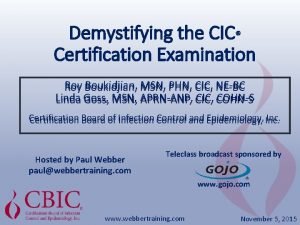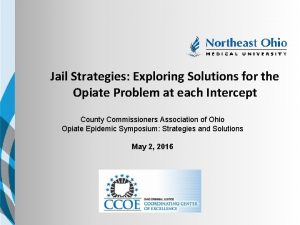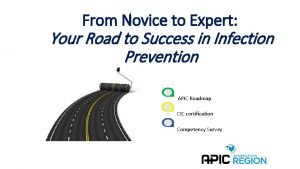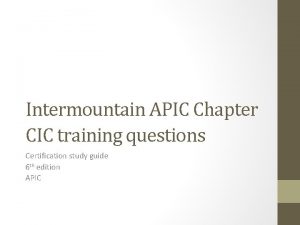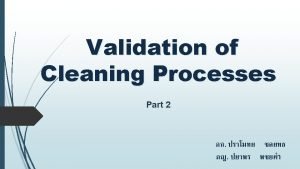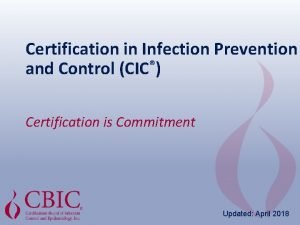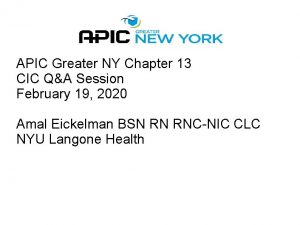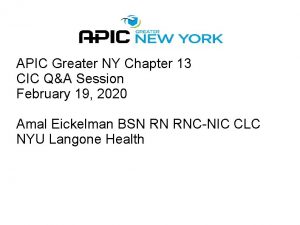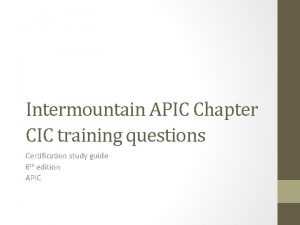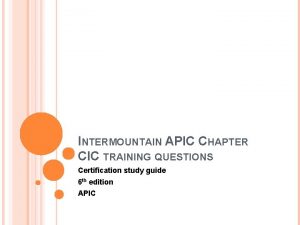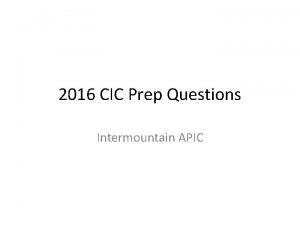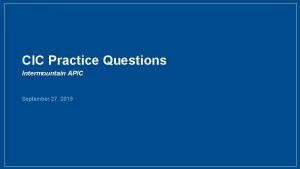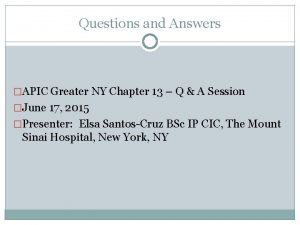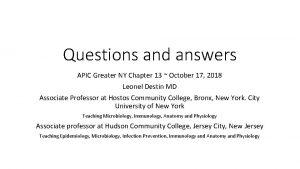APIC GREATER NY CHAPTER 13 CIC Exam Questions













- Slides: 13

APIC GREATER NY CHAPTER 13 CIC Exam Questions and Answers By: Devi Vithal RN BSN, NYU Winthrop June 19, 2019

QUESTION # 1 HOW LONG DOES IT TAKE TO GET THE FIRST SYMPTOM OF MEASLES AFTER EXPOSURE? a) Immediately after exposure b) 14 days after exposure c) 2 -3 days after exposure d) 10 -12 days after exposure 2

ANSWER # 1 How long does it take to get the first symptom of measles after exposure? It takes an average of 10– 12 days from exposure to the first symptom, which is usually fever. The measles rash doesn't usually appear until approximately 14 days after exposure, 2– 3 days after the fever begins. Symptoms include fever, runny nose, cough, loss of appetite, “pink eye, ” and a rash. 3

QUESTION # 2 WHEN SCREENING FOR MEASLES WHAT ARE THE MOST COMMON PRESENTING SIGNS AND SYMPTOMS ? a) Fever, cough, rash, pink eye, loss of appetite b) Fever, cough, runny nose, nasal congestion c) Clammy and pale skin, SOB, confusion d) Fever, chest pain, cough, chills 4

ANSWER # 2 When screening for Measles what are the most common presenting signs and symptoms ? a) Fever, cough, rash, pink eye, loss of appetite - MEASLES b) Fever, cough, runny nose, nasal congestion - URI c) Clammy and pale skin, SOB, confusion - SEPSIS d) Fever, chest pain, cough, chills - Pneumonia 5

QUESTION # 3 WHICH OF THE FOLLOWING IS LIKELY TO RESULT IN THE HIGHEST EFFICACY OF MEDICAL INSTRUMENT CLEANING? a) Use of central reprocessing area for all instrument cleaning b) Local instrument reprocessing area for all instrument cleaning c) Use of acidic p. H cleaner d) Allowing the instrument to dry after use and before cleaning 6

ANSWER # 3 Which of the following is likely to result in the highest efficacy of medical instrument cleaning? A central processing area will have the highest efficacy of medical instrument cleaning because it will often have specialized cleaning equipment and because employees in the area specialize in cleaning equipment (may be certified). 7

QUESTION # 4 A FOOD SERVICE WORKER IS DIAGNOSED WITH HEPATITIS A. HOW LONG SHOULD THIS EMPLOYEE BE ON WORK RESTRICTION? a) Until 14 days after symptoms resolve b) Until 7 days after onset of jaundice c) Until 14 days after onset of jaundice d) Until 10 days after symptoms resolve 8

ANSWER # 4 A food service worker is diagnosed with Hepatitis A. How long should this employee be on work restriction? According to ACIP, food service workers who are diagnosed with Hepatitis A must be restricted from food handling until 7 days after the onset of jaundice. 9

QUESTION # 5 PRIMARY COMPONENTS OF AN INTIAL OUTBREAK INVESTIGATION ARE: 1) Preparing a line list and epidemic curve 2) Notifying key partners about the investigation 3) Continuing case finding 4) Initiating an analytic study a) 1, 4 b) 2, 3 c) 1, 2 d) 3, 4 10

ANSWER # 5 Primary components of an initial outbreak investigation are: c) 1, 2 Preparing a line list and epidemic curve; and Notifying key partners about the investigation Rationale: In general, outbreak investigations can be divided into two major sections, the initial investigation and the follow-up investigation. 11

THE PRIMARY COMPONENTS OF AN OUTBREAK INVESTIGATION INCLUDE THE FOLLOWING: • Confirming the presence of an outbreak • Alerting key partners about the investigation • Performing a literature review • Establishing preliminary case definition • Developing a methodology for case finding • Preparing an initial line list and epidemic curve • Observing and reviewing potentially implicated patient care activities • Considering whether environmental sampling should be performed • Implementing initial control measures 12

GREAT JOB!! THANAK YOU!
 Cic certification study guide
Cic certification study guide Cic exam questions
Cic exam questions Cic certification exam
Cic certification exam Cic certification requirements
Cic certification requirements Apic model
Apic model Apic novice roadmap
Apic novice roadmap Cic certification study guide
Cic certification study guide Apic cleaning validation guidelines 2014
Apic cleaning validation guidelines 2014 Apic tutorial
Apic tutorial Zvijezda umanjenica
Zvijezda umanjenica What is a cic certification?
What is a cic certification? Cic portal zayed
Cic portal zayed Fit 2 learn
Fit 2 learn Avaya vs customer interaction center cic
Avaya vs customer interaction center cic
